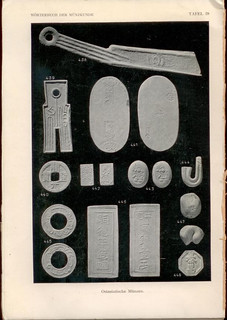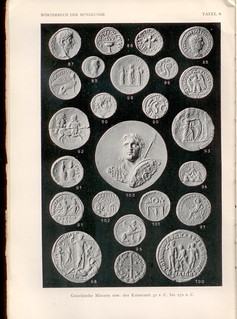
PREV ARTICLE
NEXT ARTICLE
FULL ISSUE
PREV FULL ISSUE
VOCABULARY TERM: PLASTER CASTDick Johnson submitted this entry from his Encyclopedia of Coin and Medal Terminology. Thanks. -Editor
Plaster Cast. An image of any three-dimensional object molded of PLASTER OF PARIS. Plaster casts are inexpensive, easy to make, excellent for transferring relief and superb for studying an object’s three-dimensionality. With the development of the die-engraving pantograph, plaster casts became the ideal media for which the original bas-relief design could be converted into a die. The artist could either model or carve the plaster itself, or if he worked in any other media, he could make a plaster cast from any firm medium, for a hard plaster cast that could be submitted to a mint or medal manufacturer to be rendered into a die for striking coins or medals. While plaster casts are somewhat hard they have the disadvantage, however, of scratching, chipping or breaking easily, therefore are inherently impermanent. Some plaster casts have lasted for hundreds of years (if kept dry, indoors and dust-free). But while plaster has been worked by artists for two thousand years, British Museum curator Sir George Hill once remarked that no plaster casts of medallic items have been found to have been preserved for more than a few generations. Casting in plaster -- the technique is described in the entry PLASTER CASTING -- is important in the medallic and numismatic field for the following reasons: (1) models can be created in plaster, or if modeled or carved in another media they can be cast in plaster; (2) casts of finished objects, actual coins and medals, can be made, such are called STUDY COPIES; (3) plaster casts were formerly used for photographing a number of diverse numismatic objects, and finally, (4) plaster casts of coins and medals can be framed for use as a room decoration.
Plaster casts can be positive or negative. The artist can work in either, he can add or carve detail, build up relief, smooth a surface or give it texture. Plaster is the ideal medium for creating the MODULATED RELIEF necessary for coin and medal models, and plaster of Paris casts are a useful step in such a model’s creation during manufacture. Study copies. Plaster casts of numismatic or medallic items are infrequently used for scientific or scholarly study. Museums sometimes provide casts as a service, much like a photographic service, the casts offering the ability to study the object’s three-dimensionality. In the event someone cannot visit the museum to examine the objects first hand, a three-dimension plaster cast is invaluable to study. Plaster casts of medals were sold by sculptors’ supply houses along with casts in the full round of hands, feet, torsos, busts, statues of famous works of art, people and animals. A 1911 American catalog of master caster and importer Eugene Lucchesi offered plaster casts of 50 Renaissance medals. These 50 were from the Medici collection in the National Museum, Florence, and sold in 1911 for 25 cents each, averaging 4-inch size. In addition, 250 different cameos were offered, average size 1 1/2-inch, $1.75 per dozen. Also the following plaster casts of U.S. Mint medals were illustrated: Benjamin Harrison President Medal (U.S. List 123), James Buchanin (List 115, 617 or 618), Zachary Taylor (List 421 or 423). These, like the Renaissance medal casts, sold for 25c each as well.   Plates of nonuniform medallic items of different color and reflection of the item’s surface have been published in numismatic books from mid 19th into the 20th century. Above plates appeared in the 1930 German numismatic dictionary Worterbuch der Munzkunde. Photographic aid. Formerly, when diverse numismatic objects were photographed together, those perhaps with difficult lighting problems, plaster casts were made of all the objects in a single photograph taken of all the plaster objects on one plate. Another advantage was that obverse and reverse could be shown side by side. This continued as late as 1974 when The Commemorative Medal by Howard W.A. Linecar was published in England. Books in Europe and America were illustrated in such manner. Today, more sophisticated photographic (or computer illustration) techniques are used and the practice is no longer necessary. Also there always seems to be a need for a photograph to be made of a plaster model before the die is made. This can be done by tinting the white plaster before the photograph is shot. Room decorations. A long-time use of plaster casts, particularly of large medals, has been the mounting of one or more in picture frames. The stark white against a solid color background with a gold and wood frame was an exceptionally attractive wall decoration. Plaster casts appearing on the market are usually study copies. Collections of such plaster casts have been formed but their collector or resale value is meager (as most collectors demand originals rather than replicas).
The best use of these existing plaster casts, therefore, is to frame small groups of them for wall display. Looking for the meaning of a numismatic word, or the description of a term? Try the Newman Numismatic Portal's Numismatic Dictionary at: https://nnp.wustl.edu/library/dictionary Wayne Homren, Editor The Numismatic Bibliomania Society is a non-profit organization promoting numismatic literature. See our web site at coinbooks.org. To submit items for publication in The E-Sylum, write to the Editor at this address: whomren@gmail.com To subscribe go to: https://my.binhost.com/lists/listinfo/esylum All Rights Reserved. NBS Home Page Contact the NBS webmaster 
|
